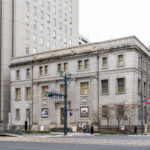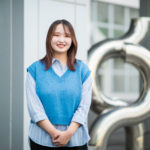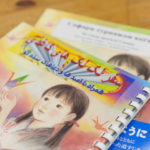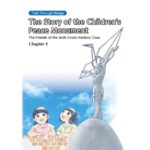1. Rescue Immediately Following the Bombing: Hijiyama Camp For Lost Children
There is a journal with “Hiroshima City Hijiyama National School, 1945” written on the cover in black ink2. On the labeled August 8th, it reads, “At 4pm, Mr. Kurose, the revenue officer, took the orphans and opened a camp for lost children.” The journal also mentions that there were five people working there, including principal, Masami Ishida, and teachers, among them Yoshie Tomasu. Under the chaotic conditions following the bombing, relief efforts began on behalf of children whose parents’ whereabouts were unknown. Hiroshima Prefecture’s record of war damage recorded that a camp for orphans was opened on August 10th in Hijiyama National School. In fact, the camp was opened two days after the bombing3. Hijiyama National School was about 2.8 km southeast of the hypocenter and escaped the fire. About 50 students in the classrooms were injured by class fragments and other debris, but all survived.
Children older than the third grade were evacuated en masse to Tsuda Village in Saiki-Gun (currently Hatsukaichi City)4. Immediately after the atomic bombing, wounded citizens evacuated to the school, which became one of the 13 emergency relief stations established by the prefecture on the 7th. The principal, Ishida, and the school’s female teachers remained there and helped care for the injured5. “There are many injured people. In addition to orphans, the camp for lost children is accommodating others, 24 people in total” (diary entry, August 9th). According to a note written by Tomasu, herself a mother, and 28 years old at the time, “I breastfed a baby crying out for its mother, and the baby went to sleep.” However, a few days later, “It died.”6 Childcare continued under extreme conditions. The camp was administered mainly by the Hiroshima City Administration. Among the documents left by Norimichi Yabuki, who later served as the head of the Tokyo Bureau of the Hiroshima City Administration, and who also worked to establish the Hiroshima City Peace Memorial City Construction Act in 1945, there is a document overviewing the Hijiyama Camp For Lost Children7. It is thought that this document was created in preparation for the inspection of Hiroshima by Torahiko Nagazumi, who was dispatched by the emperor and visited the Hijiyama Camp For Lost Children on September 3rd, 1945. Hiroshima City’s report8 to the government contained the overview.
A total of 91 people (including 36 girls) were being accommodated there by September 2nd, the day before Nagazumi’s visit. The breakdown was as follows: 40 children aged 0-5, 47 children aged 6-12, 4 children older than 13. 18 children were eventually taken by their parents, and 14 were taken by relatives, a total of 32. However, 9 children died. “They suffered from sever diarrhea, and grew weak and died.” The cause of death was acute radiation syndrome.
On the 16th of September, Hiroshima City created a list of children accommodated at the camp in order to search for their relatives and parents, and posted it on the Hiroshima Administrative Offices, Hiroshima Eastern Police Station (then provisionally serving as Hiroshima Prefectural Office), Fukuya Department Store, and Hiroshima Station. In addition, Hiroshima City twice broadcast radio messages via Hiroshima Central Broadcasting Station, (present-day Hiroshima Broadcasting Station), which resumed operations at Hara Broadcasting Station in Gion-machi (present-day Asaminami Ward).
“By helping each other, the orphans grow up.” The Chugoku Shimbun, which resumed operations using a rotary press evacuated to suburban Nukushina Mura (present-day Higashi Ward) reported on a camp for lost children on September 3.
The paper reported that the hair of the children, which had fallen out “due to atomic bomb radiation sickness” had started to grow back little by little,” and depicted them cheerfully picking wildflowers and catching frogs. The article also reported that “more than three children newly arrive every day.” It reported the names of all 35 children (12 of whom were girls) , the eldest aged 15. There was “Katsu-chan” (age five), and “two unidentified children (five and six years old, both in Koimachi on the day of the bombing).” Apparently, the young children were in such a state that they could not even tell others their names.
As of November 11th, when the emperor’s brother, Nobuhito, Prince Takamatsu, visited, there were 30 children in the Hijiyama Camp for Lost Children9. Sixteen children who had not been retrieved by anyone were transferred to Hiroshima Institute for War Children10. It is recorded that from 155 to 200 children were sent to the school11, however, it is unclear from the journal how many infants were able to meet their parents and how many died from the aftereffects of the bombing. According to Tomasu’s diary, she mourned 11 children, including the infant she had nursed12.
2 Shouwa 20 Nendo Nisshi Hiroshimashi Hijiyama Kokumin Gakko (Journal of Hiroshima City Hijiyama National School), owned by Hiroshima City Hijiyama Elementary School
3 Hiroshima Prefecture (ed.), Hiroshimaken Sensaishi (Hiroshima Prefectural History of War Damages), Daichi Hoki Co. Ltd, 1988, p120
4 Hiroshima City (ed.), Hiroshima Genbaku Sensaishi Dai 4 Kan (Hiroshima City History of Atomic Bomb Damages Vol. 4), Hiroshima City, 1971, P217
5 Hiroshima Kenchiji Takano Genshin Yukoku (Public Announcement by Hiroshima Municipal Governor Genshin Takano), August 7, 1945, owned by Hiroshima Municipal Archives
6 Yoshie Tomasu, “Hijiyama Kokumin Meigo Shuyojo Tookaichi Sensaiji Ikuseijo (Camp for Lost Children, Hijiyama National School: Itsukaichi Institution for War Children), Hiroshima Genbaku Sensaishi Dai 5: Shiryouhen (Hiroshima City Hitory of Atomic-bomb Damages Vol. 5 Statistics and Materials), 1971, pp647-648
7 Hijiyama Maigoji Shuyoujo Gaiyou (Overview of Hijiyama Institution for Lost Children), September 2, 1945, owned by Hiroshima Municipal Archives
8 Hiroshima City “Genjousho” (report to the government), September 3, 1945, Shouwa 20nen Jiju Gosaken Roku (1945 Reports by Chamberlain), owned by Archives and Mausolea Department, Imperial Household Agency
9 The Chugoku Shimbun, December 13, 1945
10 The Chugoku Shimbun, February 12, 1946
11 Hiroshima City Hall (ed.), Hiroshima Shinshi: Gyouseihen (New History of Hiroshima City: Administration), Hiroshima City Hall, 1983, p132
12 Cited above, “Hijiyama Kokumin Meigo Shuyojo Tookaichi Sensaiji Ikuseijo (Camp for Lost Children, Hijiyama National School: Itsukaichi Institution for War Children), Hiroshima Genbaku Sensaishi Dai 5: Shiryouhen (Hiroshima City Hitory of Atomic-bomb Damages Vol. 5 Statistics and Materials),p659








